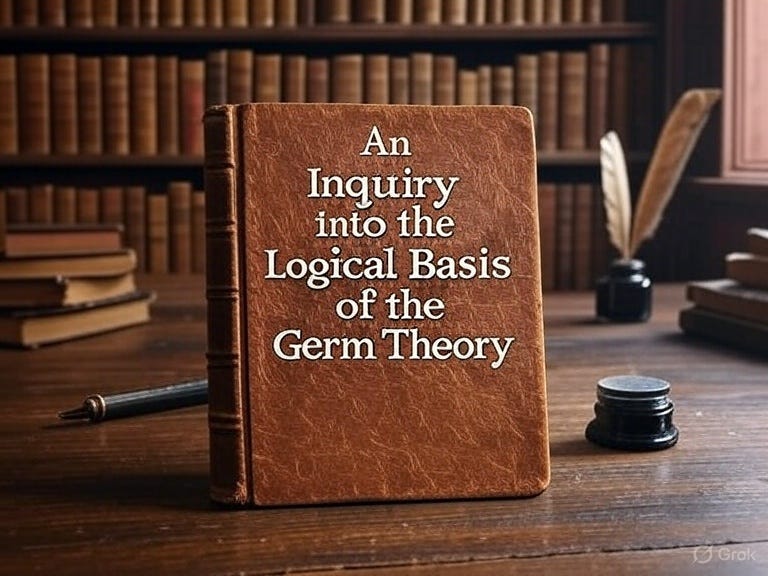On a few occassions, posters have brought up their belief in the Germ Theory of disease. I think that it has serious flaws. But before we can have a good discussion on it, we need to define Germ Theory. I think most if not everyone here would agree to Wikipedia's introduction to the term, so I'll put it up below:
**
The germ theory of disease is the currently accepted scientific theory for many diseases. It states that microorganisms known as pathogens or "germs" can cause disease. These small organisms, which are too small to be seen without magnification, invade animals, plants, and even bacteria. Their growth and reproduction within their hosts can cause disease. "Germ" refers not just to bacteria but to any type of microorganism, such as protists or fungi, or other pathogens, including parasites, viruses, prions, or viroids.[1]
**
Alright, with that out of the way, I'll now quote from the introduction and conclusion of Mike Stone's article that shares the title of this thread:
**
To those familiar with my work, it comes as no surprise that I take great interest in highlighting the forgotten voices from the formative years of germ “theory” and virology—those who examined the rise of these pseudoscientific fields with critical eyes. These individuals had front-row seats to history, and they witnessed firsthand the unscientific, contradictory foundations that shaped our modern beliefs about health, disease, and wellness. They recognized the manipulation by vested interests and warned against the manufactured acceptance of germ “theory” by a fearful, uninformed public. And they spoke out—attempting to avert what they foresaw as a grave disaster.
Amongst the earliest of these voices was the great French chemist Antoine Béchamp, a rival of Pasteur and proponent of the competing terrain theory. He astutely recognized how the public had been misled in the preface to his 1867 publication La Théorie du Microzyma (translation from Bechamp or Pasteur: A Lost Chapter in the History of Biology):
Decades before germ “theory” reached mainstream dominance, American physician Dr. Edward P. Hurd raised concerns about its flawed logic. In his 1874 paper On the Germ Theory of Disease, Hurd questioned whether germs were truly the cause of disease rather than mere byproducts of it. He specifically criticized the fallacy of affirming the consequent—the mistaken belief that if cause A (a germ) is always found with effect B (a disease), then A must have caused B. Hurd pointed out that simply showing a germ is always present with a disease does not prove causation. To establish a valid causal link, one must introduce the germ into a healthy environment and observe whether the disease follows—something germ theorists had failed to do:
In essence, Dr. Leverson ends where he began: arguing that the germ “theory,” when stripped of its rhetorical armor and emotional sway, fails to meet even the most basic standards of logic and science—and that only by returning to the foundational principles of health and reason can medicine truly serve humanity. He ended with a sober warning: that building medical practice on an unproven theory is intellectually reckless, and its dogmatic enforcement is nothing short of a crime.
Dr. Leverson’s critique of germ “theory” is ultimately a rigorous indictment of the logical and scientific flaws at its core. He highlighted how the “theory” relies on fallacies such as post hoc ergo propter hoc, affirming the consequent, and begging the question, all while shifting the burden of proof and treating correlation as causation. Through examples like the presence of staphylococcus in pus or the absurd syllogisms used to justify bacterial causation, Leverson dismantled the foundation of bacteriology with clarity and wit. He also exposed the dangers of medical reification—treating disease names as fixed entities rather than varied expressions of internal imbalance—and insisted on a return to individualized, observation-based care. In his view, the persistence of the germ “theory” is less about evidence and more about institutional authority, prestige, and dogma.
Exposing logically fallacious thinking is not merely an academic exercise—it is a safeguard against flawed systems being mistaken for truth. Fallacies, when left unchecked, allow entire fields to build their foundations on assumptions rather than facts, leading to misguided practices and, in medicine, real harm. By identifying the logical errors within germ “theory,” Dr. Leverson not only challenged its scientific credibility but also illuminated the broader danger of confusing inference with demonstration, consensus with proof.
Preserving critiques like Dr. Leverson’s is not merely a matter of historical curiosity—it is essential for the health of science itself. In an era where consensus is often mistaken for truth, and dissenting voices are readily dismissed as fringe or unscientific, Leverson’s work reminds us of the importance of challenging dominant paradigms. His arguments are grounded not in contrarianism, but in logic, careful observation, and ethical concern. Revisiting such voices ensures that medical science remains open to scrutiny, correction, and evolution. It honors the principle that no theory, however widely accepted, is above question—and that genuine progress requires the courage to confront foundational assumptions. In giving space to figures like Dr. Leverson, we keep alive the spirit of inquiry that makes science worthy of public trust.
**
Full article:

 mikestone.substack.com
mikestone.substack.com
**
The germ theory of disease is the currently accepted scientific theory for many diseases. It states that microorganisms known as pathogens or "germs" can cause disease. These small organisms, which are too small to be seen without magnification, invade animals, plants, and even bacteria. Their growth and reproduction within their hosts can cause disease. "Germ" refers not just to bacteria but to any type of microorganism, such as protists or fungi, or other pathogens, including parasites, viruses, prions, or viroids.[1]
**
Alright, with that out of the way, I'll now quote from the introduction and conclusion of Mike Stone's article that shares the title of this thread:
**
To those familiar with my work, it comes as no surprise that I take great interest in highlighting the forgotten voices from the formative years of germ “theory” and virology—those who examined the rise of these pseudoscientific fields with critical eyes. These individuals had front-row seats to history, and they witnessed firsthand the unscientific, contradictory foundations that shaped our modern beliefs about health, disease, and wellness. They recognized the manipulation by vested interests and warned against the manufactured acceptance of germ “theory” by a fearful, uninformed public. And they spoke out—attempting to avert what they foresaw as a grave disaster.
Amongst the earliest of these voices was the great French chemist Antoine Béchamp, a rival of Pasteur and proponent of the competing terrain theory. He astutely recognized how the public had been misled in the preface to his 1867 publication La Théorie du Microzyma (translation from Bechamp or Pasteur: A Lost Chapter in the History of Biology):
“The general public, however intelligent, are struck only by that which it takes little trouble to understand. They have been told that the interior of the body is something more or less like the contents of a vessel filled with wine, and that this interior is not injured – that we do not become ill, except when germs, originally created morbid, penetrate into it from without, and then become microbes.
The public do not know whether this is true; they do not even know what a microbe is, but they take it on the word of the master; they believe it because it is simple and easy to understand; they believe and they repeat that the microbe makes us ill without inquiring further, because they have not the leisure – nor, perhaps, the capacity – to probe to the depths that which they are asked to believe.”
Decades before germ “theory” reached mainstream dominance, American physician Dr. Edward P. Hurd raised concerns about its flawed logic. In his 1874 paper On the Germ Theory of Disease, Hurd questioned whether germs were truly the cause of disease rather than mere byproducts of it. He specifically criticized the fallacy of affirming the consequent—the mistaken belief that if cause A (a germ) is always found with effect B (a disease), then A must have caused B. Hurd pointed out that simply showing a germ is always present with a disease does not prove causation. To establish a valid causal link, one must introduce the germ into a healthy environment and observe whether the disease follows—something germ theorists had failed to do:
“There is no proof that all that have as yet been found are not accompaniments, or effects, and not causes of the diseased conditions with which they are found associated. Halber has not yet completed the cycle of proof necessary to establish tho causal nexus between one single disease and the micrococcus found witli that disease. He has relied exclusively on what logicians call the method of agreement—the method of difference he has not tried. It is of little account for him to show that the supposed cause A always exists with the disease B, and hence B is the effect of A. Into a preexisting set of circumstances where B does not exist he must introduce A and produce the disease. This he has not attempted, and hence his speculations are of little worth.”
[snip]In essence, Dr. Leverson ends where he began: arguing that the germ “theory,” when stripped of its rhetorical armor and emotional sway, fails to meet even the most basic standards of logic and science—and that only by returning to the foundational principles of health and reason can medicine truly serve humanity. He ended with a sober warning: that building medical practice on an unproven theory is intellectually reckless, and its dogmatic enforcement is nothing short of a crime.
Dr. Leverson’s critique of germ “theory” is ultimately a rigorous indictment of the logical and scientific flaws at its core. He highlighted how the “theory” relies on fallacies such as post hoc ergo propter hoc, affirming the consequent, and begging the question, all while shifting the burden of proof and treating correlation as causation. Through examples like the presence of staphylococcus in pus or the absurd syllogisms used to justify bacterial causation, Leverson dismantled the foundation of bacteriology with clarity and wit. He also exposed the dangers of medical reification—treating disease names as fixed entities rather than varied expressions of internal imbalance—and insisted on a return to individualized, observation-based care. In his view, the persistence of the germ “theory” is less about evidence and more about institutional authority, prestige, and dogma.
Exposing logically fallacious thinking is not merely an academic exercise—it is a safeguard against flawed systems being mistaken for truth. Fallacies, when left unchecked, allow entire fields to build their foundations on assumptions rather than facts, leading to misguided practices and, in medicine, real harm. By identifying the logical errors within germ “theory,” Dr. Leverson not only challenged its scientific credibility but also illuminated the broader danger of confusing inference with demonstration, consensus with proof.
Preserving critiques like Dr. Leverson’s is not merely a matter of historical curiosity—it is essential for the health of science itself. In an era where consensus is often mistaken for truth, and dissenting voices are readily dismissed as fringe or unscientific, Leverson’s work reminds us of the importance of challenging dominant paradigms. His arguments are grounded not in contrarianism, but in logic, careful observation, and ethical concern. Revisiting such voices ensures that medical science remains open to scrutiny, correction, and evolution. It honors the principle that no theory, however widely accepted, is above question—and that genuine progress requires the courage to confront foundational assumptions. In giving space to figures like Dr. Leverson, we keep alive the spirit of inquiry that makes science worthy of public trust.
**
Full article:

An Inquiry into the Logical Basis of the Germ Theory
The germ “theory:" a scientific foundation or a logical fallacy?



